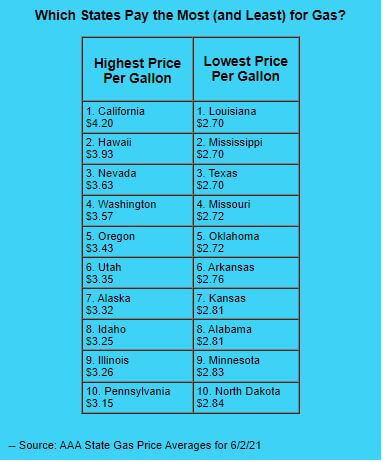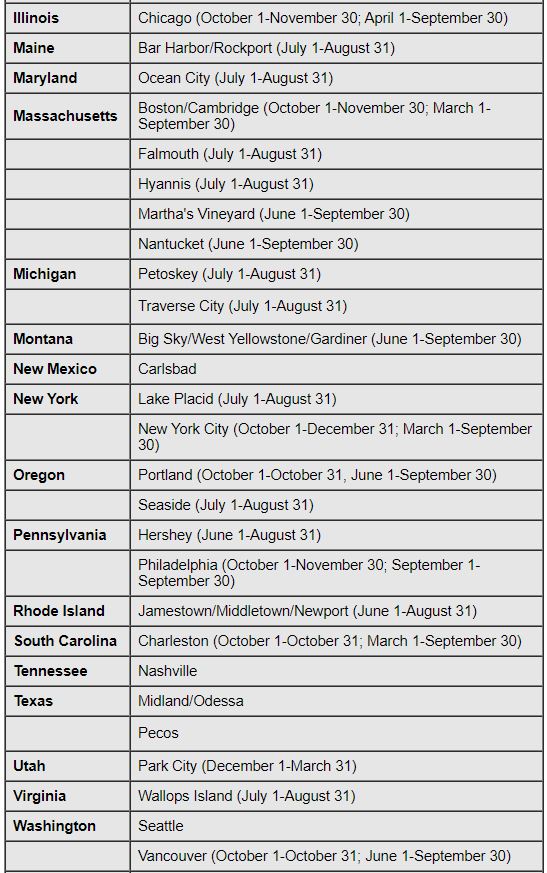Recordkeeping for reimbursing business travel expenses can be cumbersome. Instead of reimbursing employees for the actual costs they incur for out-of-town lodging, meals and incidentals, some employers opt to pay fixed travel per diems. These amounts are based on IRS-approved rates that vary from locality to locality. Here’s what you’ll need to know to determine if this simplified approach is right for your business.
The Lowdown on the High-Low Method
Under the “high-low method,” the IRS establishes an annual flat rate for certain areas with higher costs of living. All the locations within the continental United States that aren’t listed as “high-cost” automatically fall into the low-cost category. The high-low method may be used in lieu of the specific per diem rates for business destinations. Examples of high-cost areas include San Francisco, Boston and Washington, D.C. (See the chart below for a complete list by state.)
Under some circumstances — for example, if an employer provides lodging or pays the hotel directly — employees may receive a per diem reimbursement only for their meals and incidental expenses. There’s also a $5 incidental-expenses-only rate for employees who don’t pay or incur meal expenses for a calendar day (or partial day) of travel.
The following items aren’t considered incidental expenses:
- Transportation between places of lodging or business and places where meals are taken, and
- The mailing cost of filing travel vouchers and paying employer-sponsored charge card billings.
Consider reimbursing employees separately for these expenses, and then deducting the amounts as ordinary business expenses. (See “Do You Have a Plan?” at right.)
No More Receipts
If your company uses per diem rates, employees don’t have to meet the usual recordkeeping rules required by law. Receipts of expenses generally aren’t required under the per diem method. Instead, the employer simply pays the specified allowance to employees.
But employees still must substantiate the time, place and business purpose of the travel. Per diem reimbursements generally aren’t subject to income or payroll tax withholding or reported on the employee’s Form W-2. It’s also important to note that per diem rates can’t be paid to individuals who own 10% or more of the business.
Updated Rates
The IRS recently updated the per diem rates for business travel for fiscal year 2020, which started on October 1, 2019. Under the high-low method, the per diem rate for all high-cost areas within the continental United States is $297 for post-September 30, 2019, travel (consisting of $226 for lodging and $71 for meals and incidental expenses). For all other areas within the continental United States, the per diem rate is $200 for post-September 30, 2019, travel (consisting of $140 for lodging and $60 for meals and incidental expenses). Compared to the prior simplified per diems, the high-cost area per diem has increased $10, and the low-cost area per diem has increased $5.
The IRS also modified the list of high-cost areas for post-September 30 travel. The following localities have been added to the high-cost list:
- Mill Valley/San Rafael/Novato, Calif.,
- Crested Butte/Gunnison, Colo.,
- Petoskey, Mich.,
- Big Sky/West Yellowstone/Gardiner, Mont.,
- Carlsbad, N.M.,
- Nashville, Tenn., and
- Midland/Odessa, Texas.
On the other hand, these areas have been removed from the previous list of high-cost localities:
- Los Angeles, Calif.,
- San Diego, Calif.,
- Duluth, Minn.,
- Moab, Utah, and
- Virginia Beach, Va.
Important note: Certain tourist-attraction areas only count as high-cost areas on a seasonal basis. Starting on October 1, the following tourist-attraction areas have changed the portion of the year in which they are high-cost localities:
- Napa, Calif.,
- Santa Barbara, Calif.,
- Denver, Colo.,
- Vail, Colo.,
- Washington D.C.,
- Key West, Fla.,
- Jekyll Island/Brunswick, Ga.,
- New York City, N.Y.,
- Portland, Ore.,
- Philadelphia, Pa.,
- Pecos, Texas,
- Vancouver, Wash., and
- Jackson/Pinedale, Wyo.
The Fine Print
This method is subject to various rules and restrictions. For example, companies that use the high-low method for an employee must continue to use it for all reimbursement of business travel expenses within the continental United States during the calendar year. The company may use any permissible method to reimburse that employee for any travel outside the continental United States, however.
For travel during the last three months of a calendar year, employers must continue to use the same method (per diem method or high-low method) for an employee as they used during the first nine months of the calendar year. Also, employers may use either:
1. The rates and high-cost localities in effect for the first nine months of the calendar year, or
2. The updated rates and high-cost localities in effect for the last three months of the calendar year, as long as they use the same rates and localities consistently for all employees reimbursed under the high-low method.
Deductions for Employers
In terms of deducting amounts reimbursed to employees on a company’s tax return, employers must treat meals and incidental expenses as a food and beverage expense that’s subject to the 50% deduction limit on meal expenses. For certain types of employees — such as air transport workers, interstate truckers and bus drivers — the percentage is 80% for food and beverage expenses related to a period of duty subject to the hours-of-service limits of the U.S. Department of Transportation.
Example: A company reimburses its marketing manager for attending a June trade show in Chicago based on the $297 high-cost per diem. It may deduct $261.50 ($226 for lodging plus $35.50 for half of the meals and incidental expense allowance).
For More Information
Don’t let expense reimbursements for business travel become a source of frustration for you or your employees. Contact your tax advisor for ideas to simplify the reimbursement process that will pass IRS scrutiny, while eliminating administrative red tape.
The High-Cost Area List for 2020



Copyright@©2019
